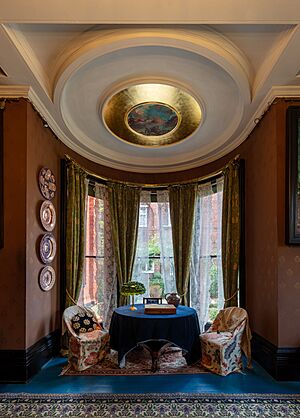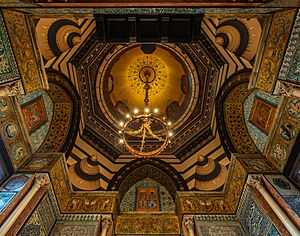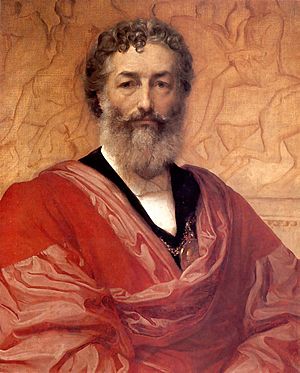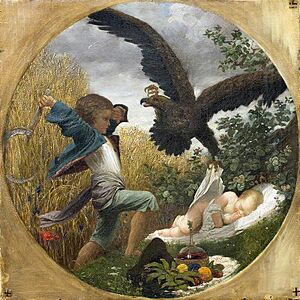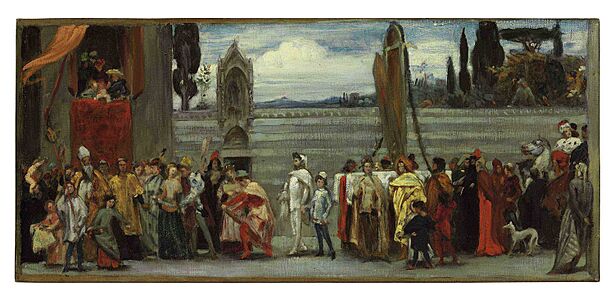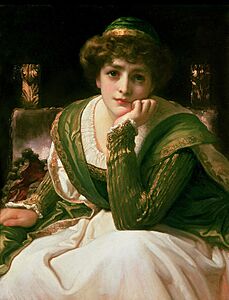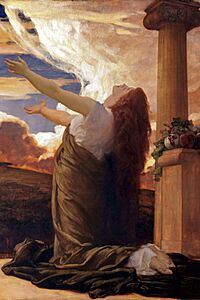Leighton House Museum facts for kids
Quick facts for kids Leighton House Museum |
|
|---|---|

View of the house from Holland Park Road
|
|
| Location | Holland Park London, W14 United Kingdom |
| Built | 1866–1895 |
| Architect | George Aitchison |
| Governing body | Kensington and Chelsea Borough Council |
|
Listed Building – Grade II*
|
|
| Official name: Leighton House | |
| Designated | 30 August 1961 |
| Reference no. | 1191541 |
| Lua error in Module:Location_map at line 420: attempt to index field 'wikibase' (a nil value). | |
The Leighton House Museum is a special art museum and historic house in London, England. It is located in the beautiful Holland Park area. This amazing building was once the home of a famous painter named Frederic Leighton, 1st Baron Leighton.
Frederic Leighton (1830–1896) asked an architect, George Aitchison, to design a house that was also a painting studio. Leighton wanted a unique home. He filled it with beautiful tiles and other items he bought during his travels to the Middle East. The house was built between 1866 and 1895. It is now a very important historical building. People love its detailed designs, which show influences from the Middle East and a style called the Aesthetic movement.
Contents
Visiting Leighton House Museum
The Leighton House Museum first opened its doors to the public in 1929. It is a great place to learn about art and history. In 1958, a special blue plaque was placed on the museum. This plaque honors Frederic Leighton and his contributions.
In 2012, the museum won a big award for its cultural heritage. It is open most days, except Tuesdays. You can also visit Linley Sambourne House, which is another Victorian artist's home nearby.
How the House Was Built
The architect, George Aitchison, started designing the house in 1864. Building began in 1866, and the first part of the house was ready by the end of that year. It was made from red bricks and light-colored stone. The style was a calm version of Classical architecture.
Aitchison kept adding to the house for over 30 years. The most important room was Leighton's studio on the first floor. It was very large, about 45 by 25 feet. It had a huge window to let in lots of light for painting. There was even a separate staircase for models to use.
The Arab Hall: A Special Room
A major addition to the house was the "Arab Hall," built between 1877 and 1879. This two-story room was made to display Leighton's amazing collection of tiles. He collected these tiles during his trips to the Middle East.
The design of the Arab Hall was inspired by a palace in Palermo, Italy, called La Zisa. It features beautiful 17th-century tiles. There are also carved wooden screens from Damascus and large 16th-century Turkish tiles. One wall has a wooden area with 14th-century tiles.
The Arab Hall also has Victorian decorations. The tops of the smaller columns were designed by Aitchison and made by Sir Joseph Boehm. The larger columns have gilded bird-shaped tops made by Randolph Caldecot. A colorful mosaic design around the top of the room was created by Walter Crane. The floor has a small fountain in the middle. Even the tiles in the hallway leading to the Arab Hall are special, made by William De Morgan.
Later Additions to the House
In 1889, a winter studio was added to the house. The last part Aitchison designed was a picture gallery in 1895. After Leighton passed away in 1896, many of his belongings were sold. This included over a thousand of his drawings.
In 1927, a woman named Mrs. Henry Perrin offered to pay for more gallery space. This new part, called the Perrin Galleries, opened in 1929. It was built to remember her daughter, Muriel Ida Perrin, who was an artist.
In 2022, the museum finished a big renovation project. It added new exhibition areas, a café, a learning center, and a storage area for its collections. It also made the entire museum accessible for everyone. A new spiral staircase features a circular mural called "Oneness" by Shahrzad Ghaffari.
Art Collection at Leighton House
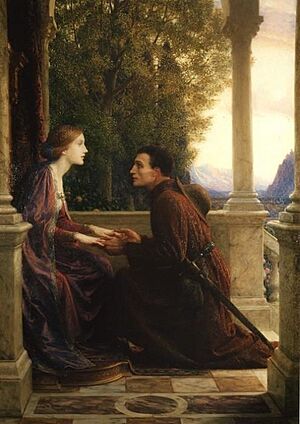
The museum has a wonderful collection of art. You can see paintings by artists from the Pre-Raphaelite Brotherhood, like John Everett Millais and Edward Burne-Jones. There are also 81 oil paintings by Frederic Leighton himself.
Some of Leighton's famous oil paintings in the collection include:
- The Death of Brunelleschi – 1852
- Hercules Wrestling with Death for the Body of Alcestes – 1869–1871
- Clytemnestra from the Battlements of Argos Watches for the Beacon Fires Which Are to Announce the Return of Agamemnon – c. 1874
- The Vestal – c. 1882–83
- And the sea gave up the dead which were in it – c. 1891–92
The museum also has other works by Leighton:
- 5 albums and sketchbooks with drawings and watercolors.
- 27 watercolors.
- 54 prints of his artworks.
- Small sculptures, like Athlete Strangling a Python (1874).
Besides Leighton's art, the museum displays other artists' works:
- A carved sculpture called Madonna of the Candleabra by Antonio Rossellino.
- A portrait of Frederic Leighton by G. F. Watts.
- A small model for the famous Eros statue by Sir Alfred Gilbert.
In 2016, Leighton's very famous painting Flaming June was brought to the museum. It was displayed in the very studio where he created it!
Works in the Permanent Collection
See also
- Holland Park Circle
- List of single-artist museums


